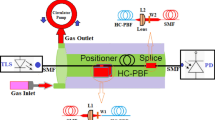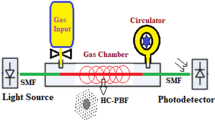Abstract
The propagation loss of a fiber can be increased by coupling core mode and surface mode which will deteriorate the performance of photonic bandgap fiber (PBGF). In this paper, we presented an aircore PBGF for gas sensing applications. By designing Λ = 2.63 µm, d = 0.95 Λ, and R core= 1.13 Λ, where Λ is the distance between the adjacent air holes, the fiber was single-mode, no surface mode was supported with fiber, and more than 90% of the optical power was confined in the core. Furthermore, with optimizing the fiber structural parameters, at wavelength of λ = 1.55 µm that is in acetylene gas absorption line, significant relative sensitivity of 92.5%, and acceptable confinement loss of 0.09 dB/m, were simultaneously achieved.
Similar content being viewed by others

References
Lopez-Higuera J M. Handbook of Optical Fibre Sensing Technology. New York: John Wiley & Sons, 2002
Olyaee S, Naraghi A, Ahmadi V. High sensitivity evanescent-field gas sensor based on modified photonic crystal fiber for gas condensate and air pollution monitoring. Optik (Stuttgart), 2014, 125(1): 596–600
Olyaee S, Naraghi A. Design and optimization of index-guiding photonic crystal fiber gas sensor. Photonic Sensors, 2013, 3(2): 131–136
Naraghi A, Olyaee S, Najibi A, Leitgeb E. Photonic crystal fiber gas sensor for using in optical network protection systems. In: Proceedings of the 18th European Conference on Network and Optical Communications and the 8th Conference on Optical Cabling and Infrastructure, 2013
Wolfbeis O S. Fiber-Optic Chemical and Biosensors. Boca Raton, FL: CRC Press, 1991
Hoo Y L, Jin W, Ho H L, Wang D N. Evanescent-wave gas sensing using microstructure fiber. Optical Engineering (Redondo Beach, Calif.), 2002, 41(1): 8–9
Lægsgaar J, Mortensen N A, Riishede J, Bjarklev A. Material effects in air-guiding photonic bandgap fibers. Journal of the Optical Society of America B, Optical Physics, 2003, 20(10): 2046–2051
Humbert G, Knight J, Bouwmans G, Russell P, Williams D, Roberts P, Mangan B. Hollow core photonic crystal fibers for beam delivery. Optics Express, 2004, 12(8): 1477–1484
Ritari T. Novel sensor and telecommunication applications of photonic crystal fibers. Dissertation for the Doctoral Degree. Finland: Helsinki University, 2006
Smolka S, Barth M, Benson O. Highly efficient fluorescence sensing with hollow core photonic crystal fibers. Optics Express, 2007, 15 (20): 12783–12791
Hoo Y L, Jin W, Ho H L, Wang D N. Measurement of gas diffusion coefficient using photonic crystal fiber. IEEE Photonics Technology Letters, 2003, 15(10): 1434–1436
Hoo Y L, Jin W, Ju J, Ho H L. Numerical investigation of a depressed-index core photonic crystal fiber for gas sensing. Sensors and Actuators B: Chemical, 2009, 139(2): 460–465
Yu X, Zhang Y, Kwok Y C, Shum P. Highly sensitive photonic crystal based absorption spectroscopy. Sensors Actuators, B: Chemical, 2010, 145(1): 110–113
Park J, Lee S, Kim S, Oh K. Enhancement of chemical sensing capability in a photonic crystal fiber with a hollow high index ring defect at the center. Optics Express, 2011, 19(3): 1921–1929
Hu J, Menyuk C R. Leakage loss and bandgap analysis in air-core photonic bandgap fiber for nonsilica glasses. Optics Express, 2007, 15(2): 339–349
Stewart G, Norris J, Clark D F, Culshaw B. Evanescent-wave chemical sensors a theoretical evaluation. International Journal of Optoelectron, 1991, 6(3): 227–238
Ritari T, Tuminen J, Ludvigsen H, Petersen J C, Sørensen T, Hansen T P, Simonsen H R. Gas sensing using air-guiding photonic bandgap fiber. Optics Express, 2004, 12(17): 4080–4087
Saitoh K, Koshiba M. Leakage loss and group velocity dispersion in air-core photonic bandgap fibers. Optics Express, 2003, 11(23): 3100–3109
Saitoh K, Koshiba M. Photonic bandgap fibers with high birefringence. IEEE Photonics Technology Letters, 2002, 14(9): 1291–1293
Author information
Authors and Affiliations
Corresponding author
Additional information
Saeed Olyaee received the B.Sc. degree in electrical engineering from University of Mazandaran, Babol, Iran, in 1997 and the M.Sc. and Ph.D. degrees in electrical engineering specializing in optoelectronics from Iran University of Science and Technology (IUST), Tehran, Iran, in 1999 and 2007, respectively. His doctoral dissertation concerned nanometric displacement measurement based on three-longitudinal-mode laser. He has established the Nano-Photonics and Optoelectronics Research Laboratory (NORLab) in 2006, and currently, he is the head of NORLab and Vice-President for Research and Technology in Shahid Rajaee Teacher Training University (SRTTU), Tehran, Iran. Dr. Olyaee presented and published more than 120 scientific conference and journal papers, book, and book chapters, and currently he is Responsible Director of Journal of Electrical and Computer Engineering Innovations (JECEI) and Member of Scientific Committee of several National and International Conferences. Dr. Olyaee's main research interests include laser displacement measurement, nano-metrology, optical instrumentation and photonic crystal fibers and sensors.
Hassan Arman received the B.Sc. degree in electronic engineering from Azad University, Lahijan, Iran, in 2001. Currently, he is a student in Nano-Photonic and Optoelectronic Research Laboratory (NORLab), Faculty of Electrical and Computer Engineering, Shahid Rajaee Teacher Training University, Tehran, Iran, working toward the M.Sc. degree in optoelectronics. Simultaneously, he is a teacher in Technical Schools in Rasht. His research interests include optical and photonic crystal fiber based sensors and optical communications.
Rights and permissions
About this article
Cite this article
Olyaee, S., Arman, H. Improved gas sensor with air-core photonic bandgap fiber. Front. Optoelectron. 8, 314–318 (2015). https://doi.org/10.1007/s12200-015-0447-5
Received:
Accepted:
Published:
Issue Date:
DOI: https://doi.org/10.1007/s12200-015-0447-5



